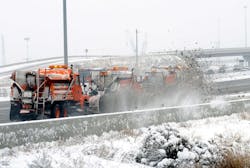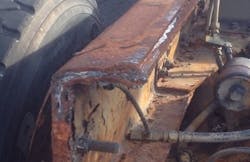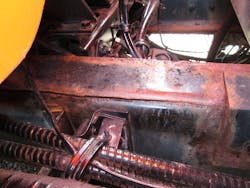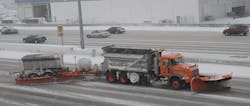Lessons from Utah and other state DOTs on addressing corrosion mitigation
Public sector agencies, primarily state DOTs, cities, towns, and toll authorities, have the primary responsibility on their respective systems of maintaining the ability for people and goods to move on a 24/7 basis, regardless of weather conditions.
Advancements in winter maintenance treatment materials and practices have resulted in increased system performance along with user expectations but also have resulted in the undesired impact of increasing corrosion and corrosion-related maintenance requirements on equipment and infrastructure.
The Utah DOT (UDOT) has dealt with the impact of corrosion on its primary equipment support tool for winter maintenance—the agency’s Class 8 snowplow truck fleet. UDOT’s core mission is identified as “Keeping Utah Moving.” A critical aspect of this mission is the agency’s performance during snow clearance and related winter maintenance activities.
Effectively, UDOT’s Class 8 snowplow trucks operate as emergency response vehicles, with operational roles that share mission-critical aspects that have more similarities with fire trucks, EMS vehicles, and similar types of equipment than “typical” fleet vehicles. In such an emergency response environment, service failures are considered unacceptable, which means these units must be maintained at a high state of readiness and replaced as necessary to ensure maximum availability and performance. Practically, this means that it is essential that these units be ready to perform their intended duties over the target asset lifecycle, historically 8-10 years at UDOT, and that funding be available to support that replacement schedule.
In 2015, UDOT faced a dilemma. Its Class 8 snowplow truck fleet was experiencing major corrosion-related damages. At the same time, authorized capital equipment replacement funding was flat while equipment needs were increasing, forcing UDOT to extend Class 8 equipment replacement beyond its historical targets. These combined impacts threatened the agency’s plow truck fleet ability to support winter operations in the timely manner its stakeholders expected.
UDOT had already changed some equipment specifications in an attempt to address these problems. These changes were based on a combination of manufacturer recommendations, suggestions of peer entities, and the professional judgment of UDOT fleet personnel rather than results of a targeted research or outreach effort. Revisions included changes to chassis design, the material used for engine oil pans, transmission pans, and differential covers, as well as changes to hydraulic system mounting locations, and the type and location of electrical connectors. However, these changes overlapped and were implemented over time, resulting in difficulty in linking specific changes to equipment corrosion outcomes.
THINKING LONG-TERM
To provide a long-term, research-supported plan for addressing corrosion issues in existing equipment, and identify optimal replacement timing and funding needs, UDOT engaged Asset Management Associates PLLC (now part of The Kercher Group Inc.) to perform six tasks that effectively focused on answering the following three questions:
1. How should UDOT address and fund the replacement or repair of the 197 Class 8 snowplow trucks that had a corrosion-prone frame design that resulted in having 58 units with cracked frames?
2. What was the optimal point for UDOT to replace its Class 8 snowplow trucks?
3. What level of snowplow truck replacement funding would be needed each year to achieve a corresponding target class age over a three-, four- or five-year period?
To answer these questions, UDOT tasked the consultants with reviewing existing fleet data and research, and performing whatever analysis and outreach was needed to provide UDOT with the appropriate guidance and recommendations. This article focuses on the equipment corrosion-related elements of this effort.
FINDINGS
The consulting team reviewed available relevant literature and research related to equipment corrosion in state DOT winter maintenance operations, Class 8 snowplow trucks, and fleets in general. The document, “Manual of Best Practices for the Prevention of Corrosion on Vehicles and Equipment used by Transportation Agencies for Snow and Ice Control,” effectively served as a synthesis of several related research documents on this topic.
The following are some of the key themes from this resource:
1. The widespread use of wet-type chemical treatments for winter roadway maintenance has significantly increased equipment corrosion damages. Based on a 2014 DOT fleet survey, these impacts are estimated by researchers as follows:
- 17.3% depreciation in equipment value
- 8.5% increase in equipment downtime
- 11.9% reduction in equipment reliability
- 17.3% reduction in equipment service life
- 19.6% increase in premature repair and replacement
- 1.5% reduction in safety, due to faulty parts on equipment
2. Roadway treatment chemicals differ significantly in terms of potential corrosion impact on vehicles and component materials. However, these differences typically are considered secondary (or not considered at all) by maintenance forces when compared to cost and perceived effectiveness of the roadway treatment material chosen.
3. Equipment component material choice has a significant impact on and susceptibility to corrosion. However, cost and other performance characteristics (strength, brittleness, longevity, etc.) must be considered in making these choices.
4. Incorporating corrosion prevention considerations in equipment design can significantly reduce corrosion impact.
5. Zinc coatings and similar protective painting materials have shown positive results in preventing/reducing corrosion. However, the quality of surface preparation and coating application vary significantly in performance.
6. Addressing paint damage or corrosion issues in early stages tends to be much easier and less costly than allowing this damage to progress.
7. Equipment cleaning after winter events and post-season cleaning and preventative maintenance are extremely important elements of avoiding/minimizing corrosion impacts.
8. Avoid leaving a truck loaded with winter deicing chemicals inside a warm garage. If the material is even slightly damp, the warmth will hasten chemical action. If a loaded truck is needed to be kept on standby, the recommended practice is to park the unit under cover outside with a block heater.
PEER SURVEY
The consultants supplemented the results of the literature review with a peer-focused survey, consisting of other western state DOTs or cities and counties that operated under environmental conditions similar to UDOT’s.
The survey covered all aspects of this project. However, the corrosion and equipment specification-related elements of this effort focused on the following survey areas: Winter roadway treatment material usage; snow material treatment impacts on vehicle conditions; mitigating the impact of winter roadway treatment materials on snowplows; equipment specification changes (i.e., to prevent/mitigate corrosion); and impact of winter roadway treatment materials on snowplow truck residual values.
Survey responses received were generally consistent with the results of the literature findings. However, as with most surveys that rely on anecdotal information and responses, not all respondents had similar experiences, as described below:
1. Most DOT respondents (75%) reported changing their roadway treatment approach in the last few years; most moved from abrasives to granular/liquid chemicals, and the reasons identified for doing so included better road clearance and less cleanup.
2. Salt (sodium chloride) was the primary material used, followed by magnesium chloride, Redmond Materials Salt/Ice Slicer, and salt brine. Eleven of 12 fleets reported increased corrosion with change. Magnesium chloride was identified as the most corrosive material used, while Redmond Salt was identified as the next most corrosive.
3. Ten fleets indicated making at least some mitigation efforts (e.g., specification changes, revised policies, etc.) that were determined to be at least somewhat effective. Four fleets indicated around 50% workforce compliance with changes; a further four fleets reported that at least one of their changes did not work.
4. Ten fleets implemented changes to mitigate corrosion impacts. These changes included one or more of the following steps:
- Post-storm washing
- Use of neutralizing chemicals, soaps and/or coatings
- Increased PM cycle frequency
- Post-event washing practices
5. Only three fleets indicated having and using undercarriage washing racks. Respondents indicated significant interest in acquiring/using more of these systems, but their ability to acquire these systems was limited by cost and/or environmental considerations.
6. Eleven fleets reported that some subset of the following equipment specifications had resulted in reduced corrosion impacts:
- Use of stainless steel bodies/beds
- Upgraded wiring workmanship requirements
- Defined locations of electrical junction boxes
- Movement to single-rail frame
7. The following equipment specification changes were reported as being ineffective or providing poor cost/benefit by at least one respondent: Stainless bodies (“just moved rust to chassis”); powder coating; and special paint.
CONDITION ASSESSMENT PROGRAM
In a related initiative, UDOT engaged Kercher to help design and implement an equipment Condition Assessment Program (CAP). The goal of this initiative was:
- To assist in identifying and triaging equipment corrosion repair needs
- To quantify the cost to mitigate corrosion damage
- To include in replacement planning and prioritization (along with age and mileage/hours)
- To support UDOT capital equipment funding requests to the state legislature
The process developed included the use of handheld devices by evaluators trained for this purpose to capture condition scores on 21 equipment components of each vehicle examined. This information was used to support a consultant-designed, UDOT-built application that gathered this information in a database that allowed reporting on current conditions as well as historic trends. This information has, in the intervening years, proven very effective in helping educate stakeholders on the costs of deferred corrosion treatment and in supporting the need for adequate capital equipment replacement funding.
As previously described, UDOT had implemented a number of changes with the goal of addressing some corrosion-related issues even before initiating this study. UDOT identified the following as changes that had proven to be effective and consistent with the literature review and survey findings:
- Shift to single-rail design mostly addressed frame cracking
- Changing oil pans and differential cover specifications to non-rusting / rust-resistant materials addressed those issues
- Improved electrical connector specs and junction box location resulted in reduced corrosion-related electrical issues
UDOT identified the following as agency practices/resource issues that remain unresolved in terms of attempting to reducing/addressing corrosion issues:
- Overall lack of wash bays or commercial washing facilities in areas served by UDOT
- Extreme winter weather encourages maintenance forces to park vehicles indoors
- Lack of facilities to gather/treat vehicle wash runoff
Of note, the project report and supporting information produced during the described initiatives have been successful in assisting UDOT in addressing the most severe issues associated with its equipment fleet. Units with critical corrosion problems have been replaced within the Class 8 fleet, and UDOT has substantially reduced the age of its fleet, as it is now approaching the replacement targets recommended by this effort.





